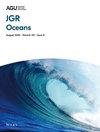A single-column coupled physical and biological model based on the North Pacific Ecosystem Model for Understanding Regional Oceanography (NEMURO) with nitrogen and silicon cycles is adapted for the Bay of Bengal (BoB) environment. The model simulated plankton biomass and nutrients along the track of Bio-Argos over East and West BoB (from 2016 to 2017) are validated with the observations. The model reasonably simulates the perennial structure of subsurface chlorophyll maximum (SCM). Further, three experiments are carried out to know the limitations in primary and secondary production in terms of nitrogen (NO3 + NH4) and silicate (Si(OH)4) in the open ocean BoB. In a “no-NO3”experiment, the nitrate limiting term [that is, NO3/(NO3 + KNO3)] is set to zero so that the difference from the control case gives the role of “regenerated production” in the total primary and secondary production. Similarly, a no-NH4 experiment was conducted to infer the role of “new production.” The new (regenerated) production fuels 85 ± 1% (28 ± 6%) of the living biomass in the East part of open ocean BoB (East BoB). The corresponding values for the west part (West BoB) are 86 ± 1% (42 ± 2%). Among the primary producers, the new (regenerated) production contributed 72 ± 1% (24 ± 6%) in the East BoB and 74 ± 1% (37 ± 2%) in the West BoB. The silicate limits the diatom production by 46% ± 22% (45% ± 27%) of the actual amount of diatom in the East BoB (West BoB) diatom. Surface to 60 m depth, we observed severe nitrate limitation over East BoB and equal limitation of nitrate and silicate over West BoB from June to September; the remaining months suffered from moderate nitrate limitation in both regions. This study shows that nitrate appears to be a limiting nutrient compared to silicate at the surface of both East and West BoB. Since silicicline is deeper than nitracline, silicate is the potential limiting nutrient in BoB from 65 to 105 m depth in all seasons.


